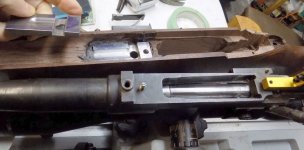BogieMan said:
The ball detent would make the bolt always off center.
Like many adjustable trigger guns that can be set to light, crisp pull, the Remington has an override or negative angle engagement at the striker cocking stud and sear interface. This means cocked striker spring pressure is bearing against a forward sloped ramp, pushing the striker, and through it the bolt body, up against any vertical slop in the bolt way in the receiver. This means the bolt tends to go to the same position in the receiver every time it is cocked, regardless of how tight the fit in the bolt way actually is. But it also means this is always off-center. The old Mauser trigger is just a direct straight vertical engagement between the sear and cocking stud, so it doesn't to that, and thus Clark's detent ball pressure forces the repeatable positioning.
How much you have to worry about thermal expansion depends on how you use the rifle. If you were shooting a Mauser or Springfield or Enfield in the Vintage Military rifle matches, where rapid fire is involved, I would be concerned about the possibility of expansion causing interference with feeding. If you shoot a match where there is time for the heat to flow and equalize between shots, I would expect the receiver, being in intimate contact with the chamber through the barrel threads, will tend to heat to the rear faster than the bolt and thus to expand more than the bolt, tending to loosen rather than tighten the fit, but this is design detail dependent and there are scenarios in which is can happen either way. You would do best, before tightening, to assemble the bolt into the receiver with some shim stock pieces surrounding the bolt to take up the slop, then do some shooting and see if an issue with the fit develops.
If no issue develops and if you have machine tools available, you can use an
inside knurl to do as Mr. Guffey described, provided you are working with a receiver that isn't case hardened where you want to upset the surface by knurling and then ream it to size.
The norm in truing guns and receivers has been to true the bolt lugs and face on its longitudinal axis, and ditto with the receiver rings and barrel threads. But I sometimes wonder, is that really best? What is expected in this arrangement is that when the striker is released and the vertical pressure ceases and the bolt body is free to wiggle in the bolt way again, the pressure on the bolt face from the cartridge firing will force the lugs to flatten and swing the back end of the bolt down into centered position. I'll have to calculate or measure the moment of inertia of a bolt or two from the lugs to back to see if there's enough force to complete that alignment when the bullet is still in the barrel or not. In the worst scenario, the bolt would swing down toward flat lug engagement and swing past it and rock until it settled.
I suspect that unless you intend to tighten the fit as Mr. Guffey does, you might do best to use the spring detents to tend to hold the bolt where the striker will position it anyway, and to lap the lugs with the bolt in that slightly off-axis position and to run a small inside toolpost grinding point or to use Dave Manson's bolt facing tool with the bolt in that position. This way the firing pressure won't tend to move the bolt alignment of the roof of the bolt way at all. It's something I'll experiment with at some point with one of my old Mausers.
As to how much difference this all makes, it will depend on the gun and chambering and whether being off axis can affect your groups. Harold Vaughn measured that it did, but he was working on a 1/4 moa gun. The designers at Savage told me they'd tried single-point turning receivers and bolts experimentally and that it they did get measurably improved accuracy, but they didn't have a way to do it within production cost parameters.

